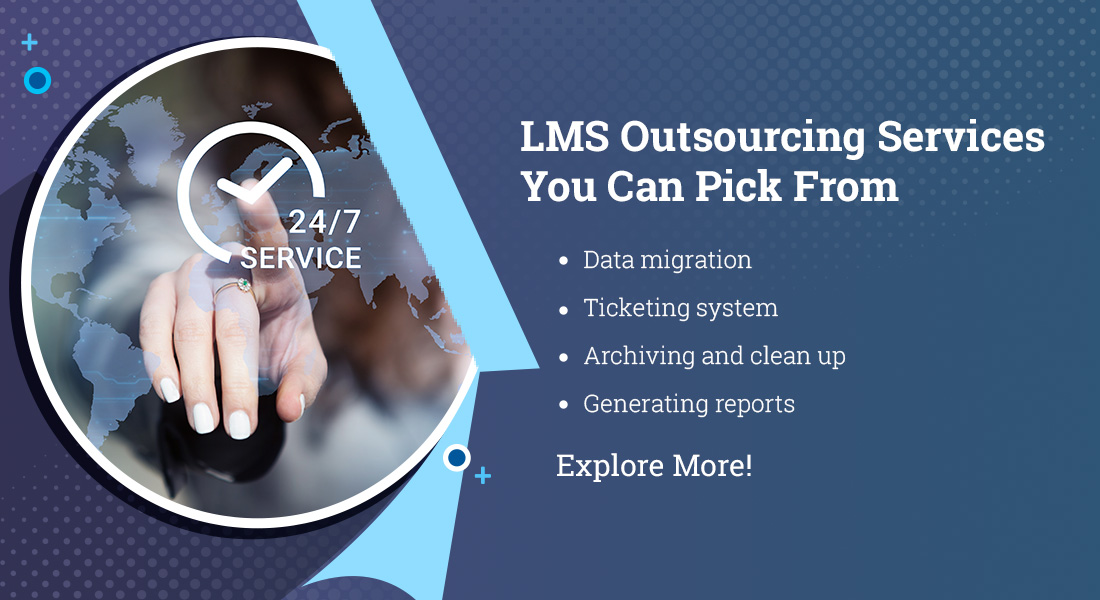Effective Learning Analytics: 4 Ways an LMS Can Help

Encouraging employees to embrace a continual learning culture is imperative if your organization wants to achieve desired business goals. In order to make this happen, it is essential for organizations to invest in the right Learning Management System (LMS). It hosts eLearning courses, schedules, tracks online training programs, and generates reports on training programs.
4 Ways an LMS Can Help with Learning
- Real time reporting
- Insights to improve learning and compliance
- Mitigate risks by monitoring compliance
- Integration with HRIS and CRM
However, how do you know if your employees find online training programs engaging enough? Are there specific training programs you need to focus on to improve productivity? Utilizing the learning analytics tools available through an LMS can provide the answers.
→ Download this handy guide on learning analytics to get started
The LMSs of today have evolved from simple e-Learning platforms to data-driven, mobile, and accessible learning channels. Here are four key ways your LMS can help you optimize the use of learning analytics within your organization.
4 Keys Ways an LMS can Help in Optimizing Learning Analytics
1. Real Time Reporting
At the heart of the use of LMS learning analytics is the capacity for report generation. The reporting capability of an LMS gives you an insight into the effectiveness of your online training programs through the provision of reports based on real-time data, tracking learners’ activity, progress, and competencies. As a training manager, here are some questions that you may have found yourself asking:
- Are employees in the organization completing the online training programs assigned to them?
- Is the training program progressing according to plan?
- Which of the courses or course types generate the highest completion rates?
- Have poor performers been able to improve as a result of the online training program?
An LMS, makes it easy to generate reports analyzing training metrics organized by employee, team, course, or business unit. Once created, the reports can be exported to Word, Excel or PDF documents for easy reference later on. The analysis of training data through the use of LMS learning analytics reports makes it possible for training managers to offer precise interventions.
In addition, organizations with specific report requirements have the option to work with an LMS vendor to generate customized reports that suit their business needs.
2. Insights to Improve Learning and Compliance
Often, an LMS hosts multiple courses that can be accessed by many employees across the organization. As a result, the LMS quickly becomes a storehouse for learner data. Learning analytics are a convenient way to utilize this data repository by analyzing the recorded rates of learning and compliance within your organization.
Apart from tracking course enrollment and completion rates, learning analytics provide training managers with powerful insights into how their employees are learning. Learners’ engagement with the course content offers valuable insights into the effectiveness of the course design.
Want to check the training compliance of your organization? Extracting the following metrics from your LMS couldn’t be simpler:
- User name and most recent login
- Number of courses enrolled in and completed
- Course pass percentage
In addition to providing insights for training managers, learning analytics are also highly beneficial for learners, as they prove an effective tool for keeping track of performance. Learner dashboards increase the utility of an LMS by making learners aware of their progress.
3. Mitigate Risks by Monitoring Compliance
Employee training and development is essential for risk management. The consequences of employees failing to complete mandatory training programs on topics such as compliance and health and safety can prove expensive as well as potentially dangerous for an organization. The LMS can mitigate risks by monitoring training compliance within your organization.
Upon logging into the LMS, employees in the organization will see notifications reminding them to complete training programs. But, for your employees on-the-go, this might not be ideal. It would be easy for them to miss out on these notifications. The LMS mitigates this risk by sending email alerts to learners in addition to the notifications, reminding them of the mandatory training program that they need to complete.
With compliance training, learners often need to complete refresher training programs in order to remain compliant. Notifications informing learners of automatic course enrollment and providing reminders of the due date for course completion are sent to learners from the LMS.
Making use of learning analytics through the LMS can help managers to keep track of the employees who take training programs seriously, and those who may require additional motivation or support in order to complete training programs.
4. LMS Integration with HRIS and CRM
Integrating the LMS with a Customer Relationship Management (CRM) tool can enable the monitoring of training programs rolled out to your partners or sales channels. It is an effective way to measure the impact of your training program. Have the sales channels been able to generate more business after completing the online training program? If yes, then by what percentage? By integrating the LMS with the CRM, an organization has all the data that it needs to quickly and efficiently measure the ROI on any given training program.
In addition to the CRM, the LMS can also be integrated with an organization’s HRIS in order to allow for the analysis of correlations between training and turnover, promotion, and employee satisfaction. This can help managers to optimize training requirements for their team members.
When employees complete training programs that help them equip themselves for a higher role or gain new skills, this data can be made accessible to the HRIS, helping organizations with succession planning. Also, when employees move to a new department, or are assigned to a new manager, changes made in the HRIS are automatically reflected in the LMS.
Learning analytics through the LMS enables you to fetch a report listing the employees eligible for promotion, and monitor how well each employee is equipped to handle the transition to a new job role or function.
Summing it Up
Today’s corporate LMS facilitates the effective use of learning analytics, bringing significant returns on initial investment. Being able to of learning analytics through an LMS has helped training managers and functional managers gain crucial insight into online training programs and the learners partaking in the training.
All the data and learning patterns collected about learners can be utilized to help organizations design personalized training programs for their employees. Are you looking for something that can help you take the initial steps of implementing learning analytics in your organization? Join us for the ‘Learning Analytics 101’ webinar on 20th Feb 2020 to know what, why, how and much more! Register now to book yourself an exclusive seat.





![Setting Clear Objectives and Goals for LMS Usage [Infographic]](https://blog.commlabindia.com/hubfs/blogs/setting-clear-objectives-lms-usage-infographic.jpg)